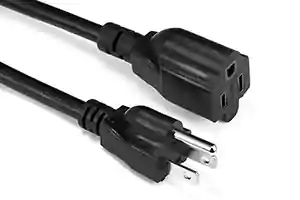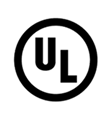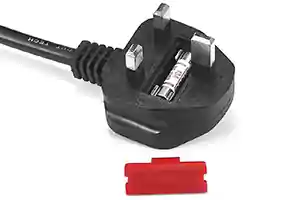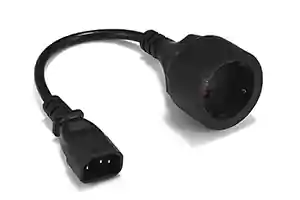The electricity Type D plug is also known as the Old British Plug. It has three large round pins in a triangular configuration and may be found in countries initially electrified by the British. It is almost exclusively used in India and Nepal.
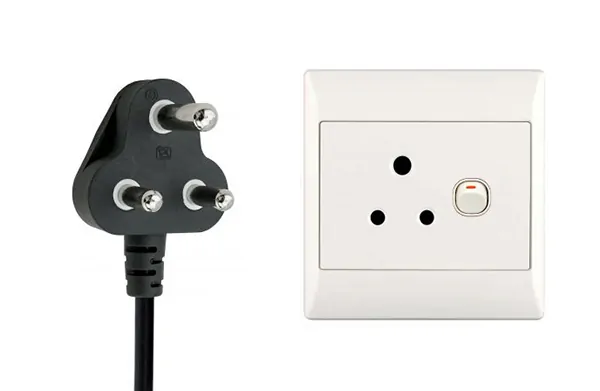
Table of Contents
What is a Type D plug?
India has standardized on a power plug that was originally defined in British Standard 546 (the standard in Great Britain before 1947). This 5 amp plug has three round prongs that form a triangle. The central earth pin is 20.6 mm long and has a diameter of 7.1 mm. The 5.1 mm line and neutral pins are 14.9 mm long, on centers spaced 19.1 mm apart.
The center-to-center distance between the grounding pin and the middle of the imaginary line connecting the two power pins is 22.2 mm. Type M, which has larger pins and is rated at 15 amps, is used alongside type D for larger appliances in India, Nepal, and Pakistan. Some sockets can take both type M and type D plugs.
There is unintended compatibility between type D sockets and various European plugs. Although the centers of the prongs of a Europlug (type C) are closer together (17.5-18.6 mm vs. 19.1 mm) than those of a type D plug, a Euro plug often fits into a type D outlet without much effort, largely thanks to the elasticity of its pins.

However, the power plug cannot be fully inserted into a D receptacle because the prongs are inelastic at the plug’s base, and they are longer than the pins of type D plugs (19 mm vs. 14.9 mm). This is the reason why type C plugs do not always make proper contact and may cause the socket to spark, which, in some cases, might result in a short-circuit.
Type D plug features
Whereas type C plugs and type D sockets could be considered an unsafe but ‘relatively workable’ combination, using E/F plugs with D outlets is downright dangerous. The centers of the pins of type E & F plugs are slightly closer together (19 mm vs. 19.1 mm) than those of type D, but unlike Euro plugs (type C), they do not have flexible prongs. This means they have to be forced into the receptacle.

This kind of improper use poses an enormous safety hazard for some reasons. Firstly – unlike type C – E & F plugs are supposed to be grounded, but when they are used with type D outlets, this won’t be the case. So, be prepared for a sparking receptacle and a regularly tripping circuit breaker.
Moreover, type E and F plugs cannot be fully inserted into a D socket because the pins are longer than the pins of the Type D plug (19 mm vs. 14.9 mm). This means that 4.1 mm of the pins of plug types E & F will still be exposed when plugged in, and if you were to touch the live prong, you most certainly would get an electric shock. This risk does not exist with type C plugs since their pins are coated in insulation.
Although type D plug is now almost exclusively used in India and Nepal, it can still occasionally be found in hotels in the UK. It should be noted that tourists should not attempt to connect anything to a BS 546 round-pin outlet found in the UK as it is likely to be on a circuit that has a special purpose: e.g., for providing direct current (DC) or for plugging in lamps that are controlled by a light switch or a dimmer.
Type D plugs are among the most dangerous ones in the world: the prongs are not insulated (i.e., the pin shanks do not have a black covering towards the plug body like type C, G, I, L, or N plugs), which means that if a type D plug is pulled halfway out, its prongs are still connected to the socket! Little children risk electrocuting themselves when pulling such a plug out and putting their fingers around it. Type D outlets are not recessed into the wall, so they do not protect from touching the live pins.
What countries use Type D plug?
Afghanistan
Bangladesh
Benin
Botswana
Cameroon
Chad
Dem. Rep. of Congo (Zaire)
Dominica
Ecuador
El Salvador
Ethiopia
French Guiana
Ghana
Greece
Guadeloupe
Guyana
Hong Kong
India
Iraq
Jordan
Kenya
Lebanon
Libya
Macao
Madagascar
Maldives
Martinique
Monaco
Myanmar (Burma)
Namibia
Nepal
Niger
Nigeria
Pakistan
Qatar
St. Kitts-Nevis
Senegal
Sierra Leone
Sri Lanka
Sudan
Tanzania
United Arab Emirates
Yemen
Zambia
Zimbabwe
What is the difference between Type D plug and Type M plug?
The Type D plug has three large round pins in a triangular pattern. Type M plugs are often used alongside Type D plugs for larger appliances, and as a result, some sockets work with both Type D and Type M plugs.
The Type M plug has three round pins in a triangular pattern and looks similar to the Indian Type D plug, but its pins are much larger. Type M plugs are sometimes used for bigger appliances in countries that use Type D plugs and in Israel (Type H). Therefore, sockets in these countries sometimes work with Type M plugs.
What plug type is used in South Africa?
For South Africa, there are four associated plug types, types C, D, M, and N. Plug type C is the plug that has two round pins, type D plug is the plug which has three round pins in a triangular pattern, and plug types M and N both have three round pins. South Africa operates on a 230V supply voltage and 50Hz.
Now It’s Your Turn
So that’s how I understand Type D plug and socket.
Now I want to turn it over to you: Through my article, do you understand Type D Plugs and Sockets (Outlets)?
Do you have a different point of view with the power plug type D? Or any other questions?
Let me know by leaving a quick comment below right now.
